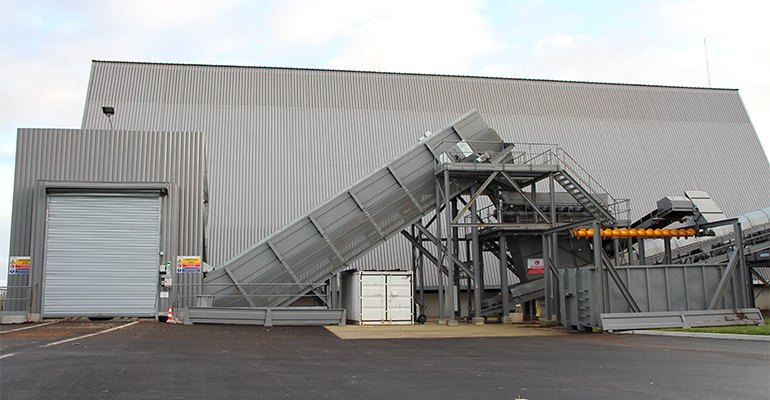When global food industry giant Nestlé sought means of reducing the carbon footprint of its Rosières-en-Santerre site in France, it struck a partnership with energy service provider Dalkia. The project has resulted in new woodchip fired plant that uses a novel chip reclaimer system.
Please reload the page
Do you want to read the whole article?
- Six editions per year
- Full access to all digital content
- The E-magazine Bioenergy international
- And more ...

In 2009, Nestlé, the global food industry company, set up a partnership with energy service provider Dalkia to help the company reduce the carbon footprint of its French manufacturing operations. The deal was to design, build and operate biomass-fired boiler plants at two of its food processing sites in Northern France; at St Pol-sur-Ternoise a meat processing plant and Rosières-en-Santerre a potato processing facility.
Each project received an investment grant from ADEME, the French environment, and energy management agency, under the 2010 national call for tenders for industrial biomass projects. The grant covered about 38 percent of each respective project financing. The Rosières-en-Santerre project was about EUR 11 – 12 million.

Located in the heart of the French sugar beet and potato district the Nestlé Rosières-en-Santerre factory recently celebrated fifty years of operation. The factory produces mashed potatoes operating six days a week around the clock with a production power-down during the weekend.
It uses about 130 000 tonnes of steam per year previously generated by gas boilers that have been retained for back-up and peak demand. They are also used during the weekly power-down and start-up as the steam demand is too low to operate the biomass boiler which shuts down on Saturday morning and restarts Sunday afternoon. The new boiler provides over 90 percent of the steam needs reducing the carbon footprint by about 46 000 tonnes yearly.
High-efficiency boiler
Commissioned in February 2013, the new Dalkia plant has a compact layout consisting of a woodchip receiving and storage facility, ash-handling along with boiler and housing all built next-door to the Nestlé factory.
The heart of the new plant is a 20 MWth rated pusher fed moving-grate biomass boiler from German fabricator Richard Kablitz & Mitthof GmbH. This vertical pass water tube and flue gas tube combination boiler burns 8 tonnes of chips per hour providing up to 30 tonnes per hour of process steam at 180 oC and 18 bar.

A special feature of the boiler is the glass tube flue gas heat exchanger that preheats the incoming air. According to Kablitz, this brings the boiler efficiency to over 92 percent without increasing the risk of corrosion at the cold end of the boiler.
There is no onsite chipping or crushing facility. Instead, the 30 mm woodchips, moisture content 33 to 42 percent, are produced from the woodlands in the region by a subsidiary of Dalkia and trucked in. The same company takes the bottom ash to a depot where farmers can collect it free of charge for use as a soil conditioner. The fly ash is sent to landfill.
On arrival, trucks pass a weighbridge before off-loading the chips into a receiving bunker and then pass the weighbridge on the way out. Each truck carries about 90 m3 or 44 tonnes of chips and the plant receives four to six trucks per day between 6 am and 6 pm.
The chips are directly conveyed to a screening unit and pass a metal detector to remove any oversized material and foreign objects before entering the storage bunker in an A-frame shed.

Innovative Tube Feeder
The bunker has an elevated horizontal concrete floor standing at breast height from the ground. The bunker walls come down to within about one metre of the bottom. Here in the gap, a Jeffrey Rader linear Tube Feeder transverses the entire width of the bunker.
Mounted on cogged rails the patented Tube Feeder consists of an outer cylinder or tube. This has a number of specifically dimensioned slots with raised hoods at specific intervals across and around it.
Depending on what position the slot is in relation to the chip stack the activated chips fall into the tube by gravity. By rotating the tube at a slow predetermined rpm and simultaneously moving the entire tube forwards or backwards under the stack, the activated chips fall into the tube enabling equal material feed-in along the entire tube.

Inside the tube is a screw auger that moves the incoming material out of the stack to a belt conveyor that runs the length outside the silo wall. The entire rotating tube moves slowly along the cogged rails about 3 mm per minute backwards and forwards down the entire length of the silo extracting chips on demand.
As the internal screw-auger is protected from the head load, less power is needed to operate the tube feeder and much less starting torque compared to a conventional screw-auger reclaimer, explained Dennis Rousseau, French representative for Jeffrey Rader.
This means less parts wear, increased operational reliability and lower operating costs. Other benefits include elimination of shear forces within the material stack, adjustable out feed rates with high accuracy on low rates, consistent chip reclaim conditions irrespective of direction and material height as well as enabling first in first out of the material.
We have to be good because we pay for any gas used by Nestlé should we fail to meet our steam delivery specifications. Therefore the entire fuel and boiler system needs to run perfectly, commented Bruno Legall plant manager for Dalkia.
This article was first published in Bioenergy International no. 1-2014. Note that as a magazine subscriber you get access to the e-magazine and articles like this before the print edition reaches your desk!


